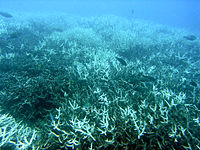
Photo from wikipedia
Extreme weathers tend to become frequent following global warming and may promote important changes in species composition. We used benthic macroinvertebrates to test the hypothesis that extreme drought events could… Click to show full abstract
Extreme weathers tend to become frequent following global warming and may promote important changes in species composition. We used benthic macroinvertebrates to test the hypothesis that extreme drought events could lead to local biotic homogenization in a floodplain pond. We took sediment samples in three sampling areas of a floodplain pond during a period of the usual hydrological cycle and during an extreme weather event that caused an atypical hydrological cycle with prolonged drought period. We found that community composition significantly differs between usual hydrological cycle and extreme drought periods, in which only species adapted to unfavorable environmental conditions remained. The spatial beta diversity decreased during the extreme drought periods, presenting lower variability compared to the usual hydrological cycle. However, species density, richness, and diversity increased during the droughts. We expect that, in scenarios of climate change with frequent extreme weathers, droughts may cause permanent negative impacts on aquatic communities, leading to biotic homogenization. Moreover, our findings indicate that prolonged droughts could increase the time needed to community recovery, suggesting lower community resilience to environmental stressors. Therefore, increasing frequency of extreme drought events may result in an alternative community structure.
Journal Title: Hydrobiologia
Year Published: 2018
Link to full text (if available)
Share on Social Media: Sign Up to like & get
recommendations!